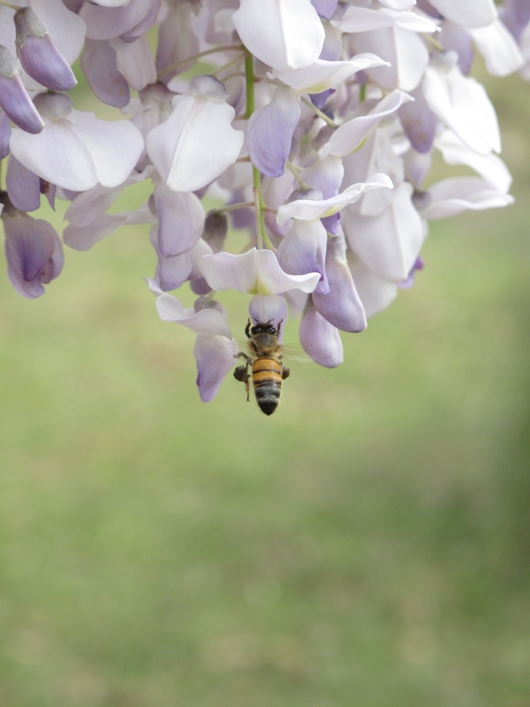I was watching some bees recently. Silently going about their business, buzzing around from one flower to another. Watching how their pollen sacks got more and more full. One poor bee could hardly keep himself up he was so laden down with pollen goodies. It was so peaceful just standing still and watching them.
From where I was standing I could see about 50 bees all gathering their pollen to take back to their hives and create liquid gold. Honey.
We had passed some hives earlier on, and it was quite possible that these little fellas would be making the 4km trek back to these same hives. Bees may travel for up to 10km in search of nectar, pollen and water if they have to. So would it be these same bees? Or were there enough flowers in their immediate hive area. In an ideal setting a bee would travel just 200 metres in search of food.
Within Australia many bee keepers will move their hives along with the changing flowering blossoms. By doing this the apiarist helps the bees find the best nectar around. The hives are usually moved at night when the bees are sleepy, and tucked up in bed.
Five little things about bees and honey
1/ Bees talk in vibrations
2/ Honey doesn’t go off.
3/ Honey can be linked back to Egyptian times.
4/ Honey can be used to soothe a sore throat, ease a coughing fit and aid sleep.
5/ Honey is a natural exfoliant when used as a face mask. No need for expensive chemical laden products.
The European honey bee was introduced to Australia in the early 1800’s. This is the type of bee that most commercial apiarists will use. There are native Australian bees, (approximately 1500) however the majority of these only produce enough honey for their own use. Only 10 out of the 1500 types of native bees produce and store honey. Sonya from The Novice Bee Keeper is a great place to start if you are interested in keeping bees or just want to know more of the processes involved. Spice and More has also just started up some backyard bees, for another interesting peek at beekeeping.
Honey is such a magnificent product. I can’t help but be a little in awe of it when I am spooning it out and drizzling it on some toast. The flavours that can be so different. The subtle changes in the different types. If you want a more flavoursome honey, try a darker variety. Generally these will be the stronger in flavour ones. Here in Australia the majority of our honey comes from the hundreds of types of eucalypts, with a few other native plants added in for more subtle flavours.
Leatherwood (from Tasmania) stringy bark, yellow box, and blue gum are just some of the types of honey produced here in Australia. So much tastier than a blended bland super market honey.
With that production of honey also comes fertilization. Fertilization of so many crops that we depend on both here in Australia and the rest of the world. (A list here on the extensive amounts of crops requiring pollination from bees.) What will happen if that pollination doesn’t happen?…Why wouldn’t it happen? Pesticides, parasites, disease, loss of habitat, farming methods all are possible contributors to the world’s downfall of bees. Colony Collapse Disorder is a name that has been thrown around a lot in the last 5 years. Are we going to be hearing of it even more in the next 5?
Did you know that the honey bee speaks Parisian street slang? Many city centre roof tops are producing honey from their own bee hive or two. Helping out with pollination within the city limits and producing gorgeous honey for its city dwellers living downstairs. I’ll be right back dear, just popping up to the roof for some honey… I can certainly see the appeal in that.
So what can you do?
* support local honey production, buy some of the liquid gold.
* plant bee (and other pollinating critters) friendly plants. You don’t need a whole garden. Even a single pot is something. Some plants bees are attracted to, lavender, bottle brush, eucalyptus, rosemary and basil. These are just a tiny few of the possibilities for plant attracting. Have a look in your area and see what is available and suitable to the climate.
* If you have the right space consider some back yard (or rooftop) bees.
There is so much information on bees, home bee keeping, colony collapse disorder, honey that I have only just skimmed the surface with this post. So many things to think about while watching the next little buzzing bee quietly buzzing about doing its thing.

